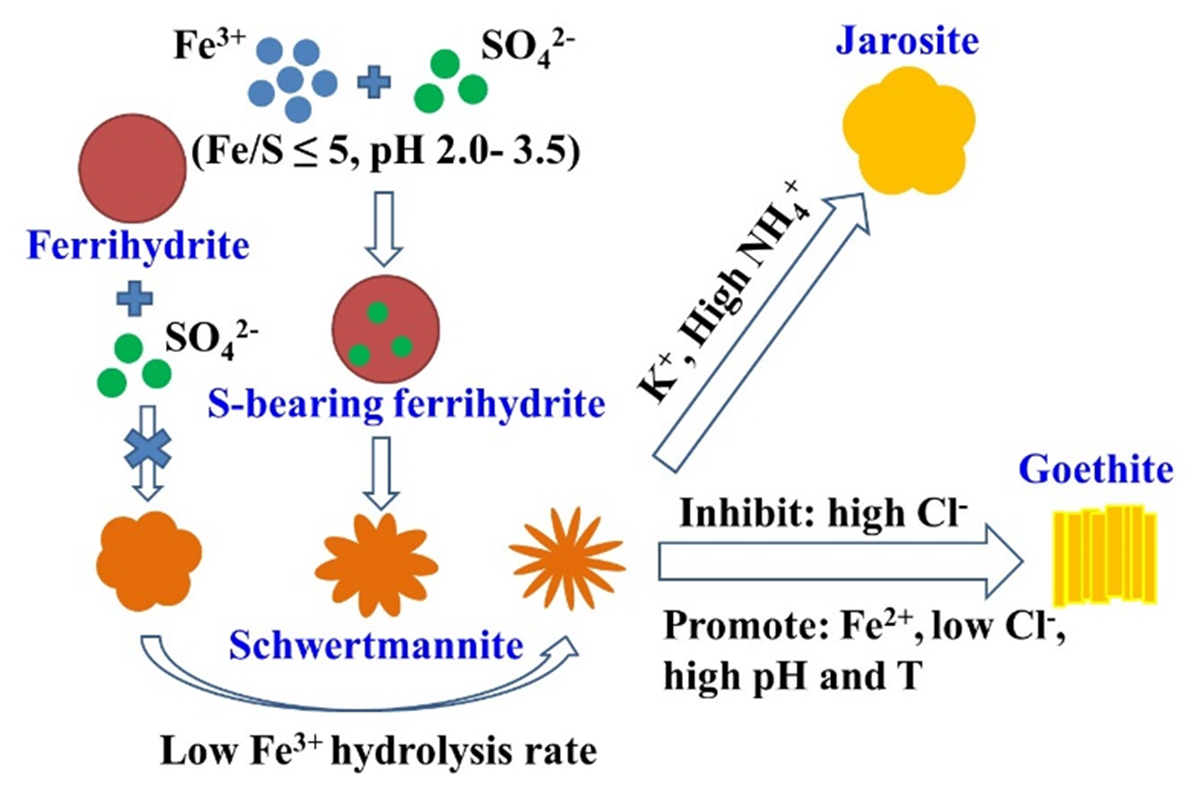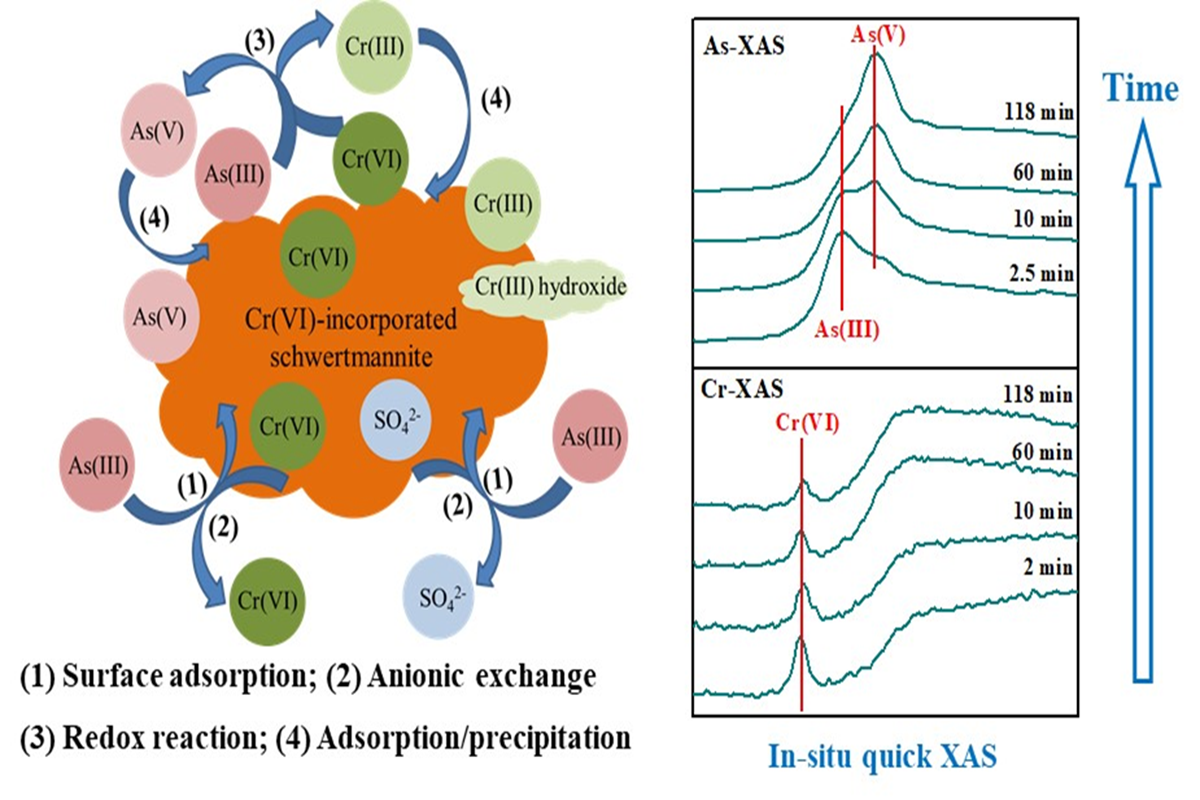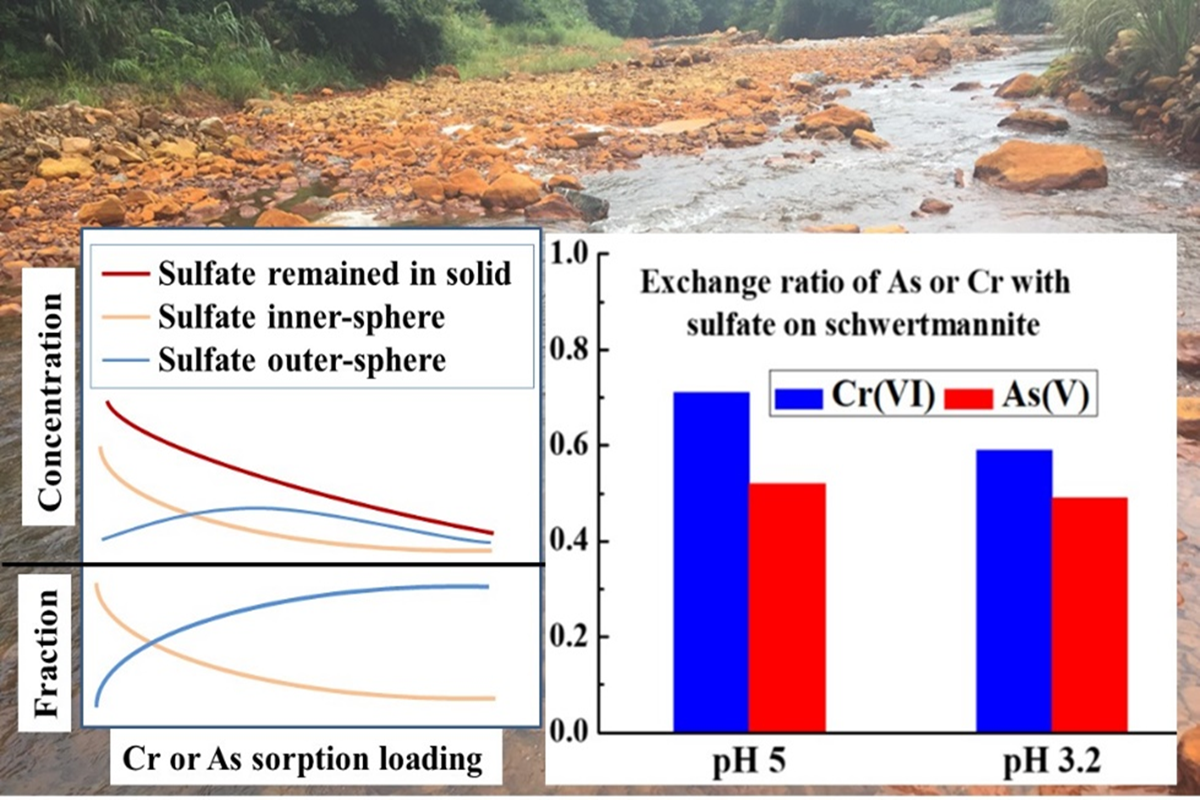南湖新闻网讯(通讯员 应虹)近日,我校资源与环境学院土壤矿物与环境团队在施氏矿物的微观结构、形成-演化及其界面重金属吸附-氧化还原行为和相关分子机制方面取得系列研究进展。研究通过宏观溶液化学分析结合电子显微镜、红外光谱和同步辐射等微观分子技术明确了施氏矿物结构中SO42-的局域配位环境、Fe3+水解过程中施氏矿物的形成条件及演化规律和Cr(VI)嵌入对施氏矿物表面As(III)吸附-氧化行为的影响,并从分子尺度揭示了SO42-交换在施氏矿物吸附Cr(VI)和As(V)过程中的作用和机制。相关成果分别发表于环境领域期刊Environmental Science & Technology和Environmental Science: Nano
施氏矿物是一种富含硫酸根的水合羟基铁氧化物,结晶度弱、比表面积大,常见于酸性矿山废水(AMD)和酸性硫酸盐土壤等环境及其周边区域,控制和影响着该环境中各种重金属污染物(尤其是含氧阴离子)的形态、迁移和归趋。其中,硫酸根的含量和形态是影响施氏矿物结构稳定性和表面反应性的关键因素。本团队首次通过硫(S)的近边与扩展边XAS,解析了矿物结构中SO42-的形态及其随环境条件的演化,表明在干湿变化过程中,结构SO42-由外圈配位向双齿双核内圈配位转化,且这种转化是可逆的(图1)。不同地球化学条件下施氏矿物的形成-演化模拟实验表明,除Fe2+氧化外,Fe3+直接水解也是其在环境中形成的重要途径,且颗粒内部嵌入有SO42-的水铁矿是该过程的中间相。在施氏矿物转化过程中,高温、高pH和共存的Fe2+均加速其向针铁矿转化,而低Fe3+水解速率和高Cl-浓度则抑制该转化;K+或高浓度NH4+则有利于诱导其向黄钾铁钒转化(图2)。

图1 施氏矿物的形成及结构中SO42-的分子配位环境

图2 不同环境条件下施氏矿物的形成-演化途径与规律
施氏矿物与砷(As)/铬(Cr)常共存于AMD等环境中,并对As/Cr有极强的吸附和富集能力,然而它们的相互作用行为与分子机制仍缺少深入认识。团队利用批量吸附-氧化实验和原位快速X射线吸收光谱(XAS),证实了Cr(VI)的嵌入可显著增强施氏矿物对As(III)的去除和氧化能力,进而降低Cr(VI)和As(III)的毒性和迁移性。具体的反应途径和机理包括As(III)表面吸附,阴离子交换,Cr(VI)和As(III)在矿物表面直接氧化还原,以及新生的As(V)和Cr(III)共吸附或沉淀(图3)。此外,从分子尺度对比研究了Cr(VI)和As(V)在施氏矿物表面的吸附行为和相关机制(图4)。结果表明,在单位吸附量条件下,Cr(VI)可交换结构中更多比例的硫酸根和更少的>Fe-OH/OH2官能团,形成双齿双核内圈络合物;而As(V)则交换比例相当的硫酸根和>Fe-OH/OH2官能团,且在高As、低pH下形成无定形FeAsO4表面沉淀。该研究还证实,虽然Cr(VI)和As(V)能同时交换硫酸根内圈配位和外圈配位,但总体上优先交换硫酸根内圈配位。上述研究结果对深入理解不同环境地球化学条件下施氏矿物的形成、结构稳定性和界面反应性具有重要意义,并为预测和评估相关环境中As和Cr的形态和生态环境风险提供了科学依据。

图3 含Cr(VI)施氏矿物界面As(III)的吸附-氧化行为

图4 施氏矿物表面Cr(VI)和As(V)的吸附行为与机制
资源与环境学院博士生应虹为部分论文第一作者,王小明副教授为论文第一或通讯作者。我校资源与环境学院冯雄汉教授和刘凡教授、美国怀俄明大学朱孟强副教授和法国格勒诺布尔阿尔卑斯大学Bruno Lanson教授等人也参与指导了部分研究工作。本研究得到国家自然科学基金、国家重点研究发展计划子课题和中央高校基础研究基金的资助。
审核人:王小明
【英文摘要】
Schwertmannite effectively sorbs chromate (Cr(VI)), yet the sorption mechanisms remain elusive. We determined the Cr(VI) sorption mechanisms on schwertmannite at pH 3.2 and 5 using combined macroscopic sorption experiments with molecular-scale characterization and by comparing them to arsenate (As(V)) sorption. Cr(VI) adsorbs as bidentate-binuclear (BB) inner-sphere complexes through exchanging more sulfate and less >Fe–OH/OH2, with 0.59–0.71 sulfate released per Cr(VI) sorbed. While As(V) also forms BB complexes, it exchanges sulfate and >Fe–OH/OH2 equally with 0.49–0.52 sulfate released per As(V) sorbed. At high As(V) loadings, As(V) precipitates as amorphous FeAsO4, particularly at low pH. The abovementioned differences between Cr(VI) and As(V) can be related to their different ionic radii and binding strength. Moreover, Cr(VI) and As(V) preferentially exchange sulfate inner-sphere complexes, increasing the proportion of sulfate outer-sphere complexes in schwertmannite. In turn, the concentration of sulfate outer-sphere complexes increases and then decreases with increasing Cr(VI) loading. Results suggest that an oxyanion, which would form inner-sphere complexes on a mineral surface, preferentially exchanges inner-spherically bound oxyanions than outer-spherically bound ones on the surface, even though both are exchanged. This study improves our understanding of the sorption of oxyanions on schwertmannite and their capabilities to template schwertmannite formation and stabilize its structure.
相关文章链接:https://pubs.acs.org/doi/abs/10.1021/acs.est.0c07980
论文相关链接:https://pubs.rsc.org/en/content/articlelanding/2021/en/d1en00104c#!divAbstract
https://pubs.rsc.org/en/content/articlelanding/2020/en/d0en00252f#!divAbstract

